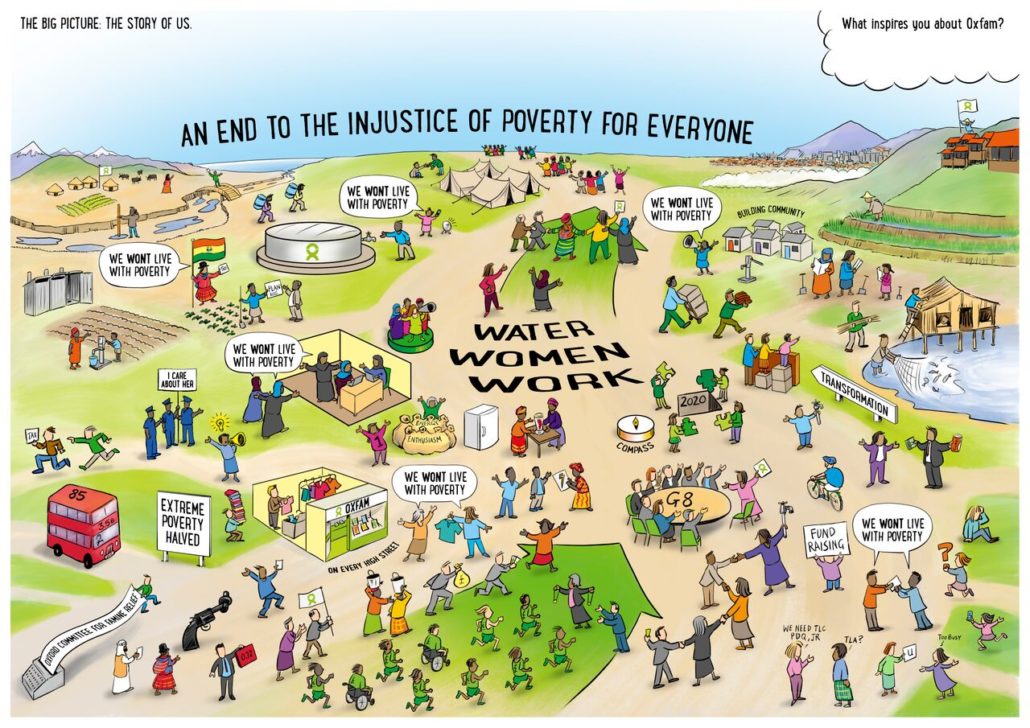Stories create a sense of purpose – but are you sharing or telling?
Storytelling is often seen as a communication tool to be used by leaders to influence an audience. But this misses one of the most powerful dimensions of stories – they are things that people, as social animals, have always shared and used to communicate deeper meaning. The sharing of stories has a powerful ability to bring people from all levels and disciplines together, help them understand each other’s perspectives and find common ground. Stories give us a common language and, through their symbolic dimension, can help people talk about meaning and purpose, in a way that is often hard to do in a corporate setting.
People are natural storytellers
There is a danger of creating too much mystique around storytelling by over-complicating it and worrying too much about developing story structure and metaphor. After all, storytelling is one of the most ancient artforms, something all societies have been doing for centuries. Preoccupation with developing storytelling ‘skills’ risks losing the authenticity that comes from people simply talking from the heart. People naturally tell stories, they do not need to be great raconteurs to do this. If the story is honest, has meaning for the storyteller and is relevant to others’ experience, it will resonate with them.
The limitations of corporate narratives
Many organisations have a corporate or brand narrative, that has been thoughtfully worked up, but are then disappointed to find that it fails to resonate with people. Most of us at some stage of our working lives will have received corporate communications that have left them cold. Oxfam GB found this after they developed a narrative that they thought would help their people to tell others what Oxfam really stands for. But, despite the narrative containing powerful imagery and compelling anecdotes, people struggled to translate this into something that helped people connect with Oxfam in a more meaningful way.
By changing the emphasis to ‘sharing’ rather than ‘telling’ stories, we were able to generate a narrative that was capable of motivating people and resonating with stakeholders. We started by people simply sharing the story of why they had joined Oxfam Through sharing their own stories and what mattered to them, they realised how important personal stories were and how the act of sharing these helped them relate to each other. Stories are one of the most important approaches we have for communicating with each other in order to understand each other’s perspectives. Presentations, lists, bullet points and logical argumentation are great but provoke the natural critic in all of us. We tend to look for the flaws in the point of view presented to us. With stories, however, different parts of our brains process the information. Rather the look for flaws in arguments we are more likely to respond to the emotions and the experiences we hear.
A picture paints a thousand words
Just because it’s a cliché, doesn’t make it less true! Stories help us to ‘see’ the world from the perspective of other people. More parts of our brain are activated when we hear a story and we experience the world the story teller is trying to convey in a more vivid way. We can literally picture the world being described as we are invited into the story teller’s world. People have emotional responses to stories as their “resistance” falls which makes it a more memorable and influential experience.
Stories naturally generate metaphors and visual imagery. And these can be turned into actual imagery. At Oxfam, the team used their personal stories to develop a picture that captured the spirit of Oxfam – a global movement of millions of people who share the belief that poverty isn’t inevitable in a world rich in resources. This became “the Story of Us” and was used as a way to help colleagues to share their own stories.
The team at Oxfam used this picture as a prompt to have conversations with other groups of Oxfam people about their own stories. The simple act of sharing stories had a dramatic impact on how connected people felt to the organisation. During this time, the percentage of people agreeing that they experienced a strong sense of shared purpose within Oxfam doubled.
“We always talk about how we’re a movement of people working towards the eradication of poverty together, but sometimes we get so caught up in the day-to-day tasks and occasional politics that it is easy to forget how cohesive a movement we actually are.”
The importance of purpose
Developing the storytelling skills of leaders is often seen as an important part of creating a powerful corporate narrative that can give employees a sense of purpose. Simon Sinek’s “How great leaders inspire action” remains amongst the top viewed Ted Talks, with over 28m views in 2016. His subsequent book “Start with Why” outlines the argument that purpose driven leaders and companies inspire others to action.
Increasingly, companies are seeking to improve the way they share meaning and purpose and a big driver of this is the competition for young talent. Gallup, one of the organisations at the forefront of employee engagement measurement over the last 20 years, analysed the views of Millennials, those born between 1980 – 1996 about what they want from work. The most significant issue was a shift away from a focus on reward towards a focus on Purpose:
“Millennials don’t just work for a paycheck – they want a purpose. For millennials work must have meaning. They want to work for organizations with mission and purpose.”
Gallup, How Millenials want to work and live, 2016
Oxfam’s experience demonstrates that strategic storytelling needs to focus just as much on harnessing our natural storytelling skills as it does on developing those of the leadership. Sharing is an act that can take place throughout every level of the organisation. Sharing personal stories about “why I work here” helps people to understand how their own job fits into the bigger picture in a more powerful way than simply being told by the leadership team. Sharing stories also helps people to create their own sense of purpose for themselves, from the conversations they have with each other.
Harnessing the power of storytelling in this way doesn’t depend on your organisation having a global cause to fight for. New Look, the fashion retailer, has used this approach to improve customer experience by encouraging their people to tell stories about how they make customers feel better about themselves. And TUI the travel company encouraged its people to talk about how they made travel experiences special for their customers.
Less telling, more sharing
Storytelling can be used to help people connect with organisational purpose and meaning. However, rather than depending upon a small group of leaders transmitting their version of a narrative, a more effective approach is to involve everyone. The small act of sharing stories is something that we can all participate in and can make a major difference to the way that people feel about their work. In the words of one of the team that ran the sessions,
“Feelings are not tangible, but I know that in the sessions that I ran, people left feeling good and empowered and wanted to do more. I had laughter, tears and real pride in the room.”






